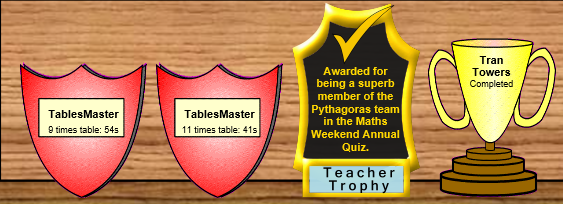Sign In | Starter Of The Day | Tablesmaster | Fun Maths | Maths Map | Topics | More
This is the June 2015 Transum Newsletter bringing you the latest news from Transum Mathematics.
The puzzle for this month is about a game in which a coin is tossed repeatedly. If it comes up heads Pascal gets a point but if it comes up tails Fermat wins a point. The first person to win three points is the winner and receives the prize of £12.
Unfortunately the game had to end abruptly after three tosses of the coin. Pascal had two points and Fermat had one point. They decided to share the £12 in a ratio that matched the probability of them winning the game if it had continued. How should they divide the £12? That should give you something to mull over as you go about your activities today. It is worth noting however that if you think the answer is £8 and £4 you may have some more thinking to do. The answer is at the end of the newsletter but don’t look if you want to figure it out for yourself.
Hundreds of virtual Transum Trophies are earned by pupils around the world each day for completing a Transum online activity. The trophies are collected in their own virtual trophy cabinet online which the pupils can proudly show to their teacher, parents or friends.
As a Transum subscriber you can award Teacher Trophies to your pupils for all sorts of achievements. You could issue a trophy for a good effort, taking part in a group project or any reason you see fit. Each pupil can receive a maximum of one Transum Teacher Trophy each day.
The button linking to the trophy awarding page is on your ‘My Account’ page.
 As usual there have been a number of additions to Transum Mathematics last month and here is a roundup of those worth mentioning.
As usual there have been a number of additions to Transum Mathematics last month and here is a roundup of those worth mentioning.
For those of you involved with teaching Formal Written Methods there are some examples of standard ways to set out the calculations along with buttons linking to online exercises providing some practice.
Five related activities are provided to support your teaching of correlation. The starting point would be Cartoon Scatter Graph which is a very visual way to convey the concept of the scatter graph. Pupils have to place cartoon characters on a set of axes to show their heights and ages.
To introduce the concept of correlation there is nothing more memorable than being a part of the graph yourself so Human Scatter Graphs is a highly recommended next step. This resource provides pairs of variables, each relating to the pupils, and asks them to find their position in the room relative to a set of very large axes.
Next is a sorting activity called Correlation which consolidates the understanding of different types of correlation.
The basics are covered by Plotting Scatter Graphs which ensures that the pupils practise the manual point plotting skills before they learn to leave the hard work to the calculator when answering Exam-Style Questions.
Now special awareness skills are a funny old phenomenon. Some children find activities so easy while others struggle, and it is not always the best mathematicians that do well. To provide practice there are a number a different ways you can approach this. Try Net or Not and Plans and Elevations. There is no substitute for making models and setting up situations in the classroom to really get to the bottom of this topic though.
The most popular online exercises, if the number of trophies earned is the defining criteria, are the basic arithmetic quizzes. A new basic exercise called Powten has now been added which has a number of levels, containing twelve questions each, requiring an understating of the easy methods of multiplying and dividing by powers of ten.
Thanks to everyone who have ever given a Starter a score. If you click on the stars on a Starter page you can see a bar chart showing the distribution of the votes. Currently the most popular starter of the year is How Many Triangles and the least popular is Chin Ups. I wonder why!
Finally the answer to the puzzle posed at the beginning of this newsletter. Consider the following equally likely scenarios for the outcome of the next two tosses:
Three of the four possibilities would make Pascal the winner so the prize should be shared in the ratio 3:1 meaning that Pascal should receive £9 and Fermat should receive £3.
Not many people get the right answer first time! This puzzle is just one of the Advanced Starters designed for older students.
That’s all
John
P.S. What did the mathematical acorn say when it grew up?
A. Gee I'm a tree (Geometry).
Do you have any comments? It is always useful to receive feedback on this newsletter and the resources on this website so that they can be made even more useful for those learning Mathematics anywhere in the world. Click here to enter your comments.
Did you know you can follow this newsletter on Substack completely free of charge? Please note this is separate from a paid subscription to the Transum website, which unlocks a much wider range of premium resources.